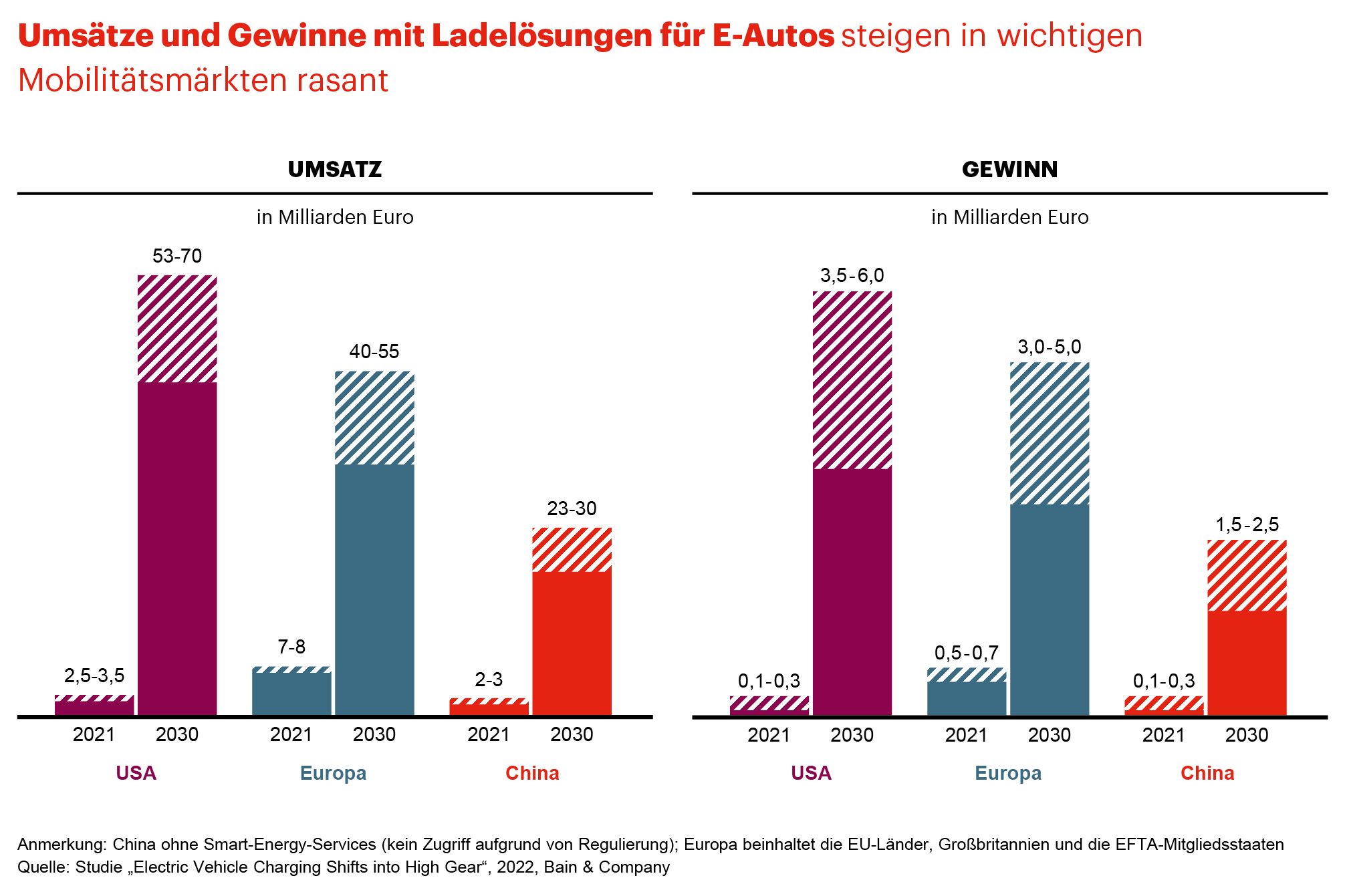
Further increases in the number of new registrations of e-cars worldwide and the recent decision to phase out internal combustion engines in the EU from 2035 are contributing to a further acceleration of the shift towards vehicles with electric drives. This requires a rapid expansion of the charging infrastructure. In its study “Electric Vehicle Charging Shifts into High Gear”, the international management consultancy Bain & Company analyses the charging options for e-car users and shows how potential providers can successfully position themselves in the billion-dollar market of the future.
New-look petrol stations are not enough
“Tomorrow’s markets are being distributed today,” emphasises Dr. Eric Zayer, Bain partner and co-author of the study. That is why car manufacturers and suppliers as well as electricity companies, but also oil and gas groups have already started to secure the best locations together with partners and to build digital platforms. “Many companies want to participate in the boom that will start around charging infrastructure for e-cars.” In fact, according to Bain analyses, revenues in this area will rise to 40 to 55 billion euros by 2030 in Europe alone. Currently, it is 7 to 8 billion euros. Profits, in turn, are likely to be up to 5 billion euros. Turnover in the USA will be even higher. By the end of the decade, 53 to 70 billion euros are expected there (figure).
Most of the money will initially flow into the construction of fast-charging stations in congested regions. However, this should not be solely about filling stations in a new guise. “Many drivers of e-cars prefer charging at home or at work in everyday life and need fast-charging stations especially on long distances,” explains Dr. Ingo Stein, Practice Director Automotive and Mobility at Bain and co-author of the study. “Which charging options will prevail where will depend on the prevailing residential situation and national regulation, but also on the individual preferences of users and their respective driving and charging behaviour.”
E-vehicles become energy storage and dispensers
In the medium term, those solutions that link vehicle charging with next-generation smart energy services will be of great importance. Such smart energy services should already account for about one third of global profits in 2030. The focus is on so-called vehicle-to-grid and vehicle-to-home concepts. In essence, this means that vehicles not only draw electricity from the grid, but can also store it and release it again. “The batteries of electric vehicles will develop into an important intermediate storage device to balance supply and demand in the strongly fluctuating renewable power generation,” says Stein.
Pioneers develop clear action scenarios
In Bain’s view, five different charging options will play a central role in the expansion of the corresponding infrastructure, which in turn will necessitate suitable business models: charging on the move. Setting up fast-charging stations requires high investments, which can amount to up to 150,000 euros. In order for the stations to meet with broad acceptance and thus pay off, a reliable and rapid charging process, well-chosen locations as well as additional services, such as WiFi or a roof, are required. Charging at the destination. Even at high-traffic locations such as supermarkets and restaurants, trouble-free charging at the appropriate speed at competitive prices must be guaranteed. Charging at home. Easy installation of the charging solution at home as well as attractive tariffs in combination with an electricity contract and smart home offers are important prerequisites for home owners to increasingly opt for e-vehicles. Charging at the workplace. Many employers are likely to make this possible for their employees in just a few years. To score as a provider, simple operating models and favourable prices are needed. Smart Energy Services. Energy companies will rely on providers of smart energy services that can give them reliable access to a large number of parked vehicles. The greatest potential is around offices and factories as well as in residential areas.
Bain partner Zayer sums up: “Regardless of the currently rising electricity costs, the trend towards battery electric vehicles is unbroken. Anyone who wants to invest in the ecosystem around the charging infrastructure for e-cars must analyse the market in detail, identify opportunities and develop concrete action scenarios.” And he adds: “The winners will be those who recognise early on which drivers will use which charging points in the future and which services they can expect there.” www.bain.com
This is an article from the current eMove360° magazine in german language – download a free PDF or order a print version by sending an e-mail to sabine.metzger@emove360.com.